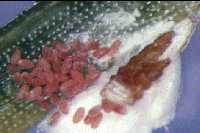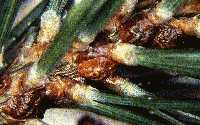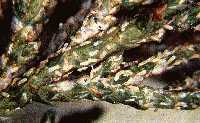by W.S. Cranshaw *
Quick Facts…
- Several species of scale insects develop on conifers in Colorado. Pine needle scale and striped pine scale are particularly damaging.
- The most vulnerable stage of the scale insect’s life cycle is the crawler stage, an active unarmored stage that occurs after egg hatch.
- If insecticide applications are made for control, proper timing is important in their success.
Scales are some of the most important insect pests affecting conifer trees and shrubs in Colorado. As scales feed on bark and needles, they remove sap and may damage cells. This can lead to decreased vigor, needle drop and dieback, and increased susceptibility to other insects or disease. Some scales also excrete sticky honeydew, which further detracts from plant appearance and attracts nuisance bees and wasps.
There are several important scale insect pests in urban Colorado. Pine needle scale has long been the most damaging species. However, the striped pine and pine tortoise scales have also become pests along much of the Front Range. Several additional species are of minor or occasional importance to pines and spruce.
Pine Needle Scale
The pine needle scale (Chionaspis pinifoliae) feeds on the needles of most species of pines, spruce and fir. During outbreaks, needles may be nearly covered with the bodies of the scales, giving an appearance that the plant is spattered with white paint. Heavily infested needles drop prematurely. Sustained outbreaks cause needle loss and sometimes twig dieback.
 |
Figure 1: Pine needle scale. |
The adult (mother) pine needle scale is about 1/8 inch long, white to grayish-white, and is always found attached to evergreen needles. Many of the scales overwinter in the egg stage beneath the covering and body of the mother scale. Pine needle scale eggs are tiny and a rosy-purple color. Some mother scales survive the winter, especially during a mild season, and can continue laying eggs into the spring. This can greatly extend the period of egg hatch.
Additionally, egg hatch dates vary with elevation and seasonal temperatures. An early hatch, sometimes beginning in late April, can occur following periods of warm weather in late winter and early spring. Under cooler conditions, initial egg hatch can be delayed until as late as the first week of June. If cooler weather persists all spring, hatching can continue for a month or more.
 |
Figure 2: Pine needle scale exposed from cover while laying eggs. |
Newly hatched scales are called crawlers. They are minute in size, a similar rosy-purple color as the eggs, and somewhat resemble tiny aphids. This is the only active period in the life cycle of the pine needle scale. Individual crawlers move about for hours to days before inserting their mouthparts into the needles. Populations can be active for up to three weeks. Shortly after settling, the scales molt (shed) their covering and produce a golden brown form. Once these insects produce their protective waxy covering (armor), chemical control can be difficult. The female scales remain stationary throughout the rest of their lives; male scales feed for a period of a few weeks and emerge as winged adults.
At higher elevations, pine needle scale produces only one generation per year. However, at lower elevations a second generation is common in mid-to late summer. Because egg hatch may be extended, a distinct second generation does not always occur. These later-emerging young primarily settle on the current season needles.
Pine Needle Scale Control
Several natural enemies are associated with pine needle scale colonies in Colorado. A minute lady beetle (Coccidophilus atronitens) is commonly found feeding on eggs and developing scales in the spring and summer. Several species of chalcid (parasitic) wasps also are common. To see if these beneficial insects are present, examinine the white, waxy cover of the scale. Parasitic wasps produce small, round emergence holes near the center of the cover. Predatory lady beetles chew more irregular holes. Unfortunately, natural enemies of pine needle scale are not always sufficient to prevent damaging outbreaks.
Pine needle scale is more readily controlled with horticultural oils than are some other armored scales, such as oystershell scale. Oils applied during the dormant season (dormant oils) are recommended for pines. Spruce may temporarily discolor at the rates used for these treatments (about 2 percent concentration). Alternatively, oils that can be used during
the growing season can be very effective. These summer oil applications can kill young, settled scales, as well as crawlers and eggs. Do not apply horticultural oils when new growth emerges or if plants are under stress from drought. Summer applications also can discolor spruce.
Often, the most effective controls of pine needle scale are “crawler sprays,” insecticides applied to coincide with the vulnerable crawler stage of the insect. Many yard and garden insecticides are labeled for this purpose, including insecticidal soaps, Sevin, Permethrin, Orthene, cyfluthrin and various oils.
Apply crawler sprays shortly after egg hatch, which can be determined by monitoring. The small, rosy-colored crawlers are detected by shaking a branch over a piece of white paper. Try this survey when crawlers are expected to first appear, from late April to late May. If egg laying and crawler activity occurs over a period of several weeks, repeat applications of insecticides, particularly if short-lived residual treatments (soaps, oils) are used. To conserve natural enemies, avoid insecticides at other times in the life cycle of the scale.
On many plants, infestations are localized and can be controlled with spot sprays.
Striped Pine Scale
 |
Figure 3: Striped pine scale. |
Striped pine scale (Toumeyella pini) has greatly increased in importance along the Front Range. It is a soft scale (Coccidae) that is primarily damaging to Scotch pine. Pinyon, Austrian and lodgepole pine also have been affected. Infested trees can decline rapidly in vigor. An increase in bark-infesting woolly aphids (Pineus spp.) also appears to be associated with striped pine scale infestation. striped pine scale excretes large amounts of honeydew as it feeds, which results in a sticky covering on twigs and needles. Dark gray sooty mold fungi grow on the honeydew, further degrading the appearance of infested trees. Nuisance bees and wasps are attracted to the honeydew.
Striped pine scales spend the winter as fertilized, immature females attached to the twigs of the current season’s growth. Some mature females may also overwinter. Adult females are somewhat round, wrinkled, and have tortoise-shell coloration (light brown to reddish brown with dark brown to black markings). In addition to the black markings, one or more cream-colored stripes occur down the center of their dorsal surface. Females begin to mature eggs in May and early June, at which time they have grown to about 1/4 inch in diameter. Eggs hatch under the covering of the mother and crawlers begin to emerge by early June. A single female can lay hundreds of eggs that hatch over a period of several weeks.
Striped pine scale nymphs are generally orange to brown. Female scales remain on the twigs while males migrate to the needles. Males become enclosed in a papery covering as they mature. They emerge to mate with the females in late summer. There is one generation per year.
Striped Pine Scale Control
Several common birds, including house finches and yellow-rumped warblers, feed on striped pine scale adults. Larvae of green lacewings and brown lacewings feed on crawlers and small females. However, no highly effective natural enemies of striped pine scale have been identified in Colorado.
Controls for striped pine scale are generally similar to those for pine needle scale. Horticultural oils used both in the dormant season or in the summer can be effective. Insecticides that can be applied to crawler stages include Sevin, malathion, and Orthene. Optimal timing to spray for crawler emergence typically occurs around mid-June. In addition, striped pine scale can be controlled with soil applications of the systemic insecticide imidacloprid (Bayer Advanced Garden Tree & Shrub Insect Concentrate).
Minor Scale Pests Affecting Conifers
Several additional scale species occur. However, most are uncommon. They often exist as isolated infestations and rarely cause significant injury.
Black pineleaf scale (Nuclaspis californica).
This scale is rare in the state but is found on ponderosa pine and blue spruce. Adult females are less than 1/8 inch long and have a circular, brown to black waxy covering with lighter margins. Published information suggests that black pineleaf scale usually is associated with stressful growing conditions.
 |
Figure 4: Juniper scale. |
Juniper scale (Carulaspis juniperi). The juniper scale sometimes attacks the needles of juniper, particularly Pfitzer juniper, and is associated with dieback during outbreaks. This scale is generally creamy white, with females more elongated and larger than males. It overwinters as eggs under the covering of the mother scale.
Spruce-bud scale (Physokermes piceae). The spruce-bud scale also rarely occurs in the state and is associated with spruce. Adult females are nearly spherical and dark brown, with older adults closely resembling undeveloped buds. This is a soft scale that produces honeydew.
Pine tortoise scale (Toumeyella parvicornis). This scale is closely related to the striped pine scale, with which it is commonly confused. Life histories, host ranges and control methods appear to be similar for both species.
 |
Figure 5: Pinyon-needle scale, “bean stage” nymphs on needles. Photo courtesy of USDA Forest Service. |
Fletcher scale (Parthenolecanium fletcheri). All stages of this scale feed on stems and branches of juniper and yew. Adult females are 1/8 to 1/4 inch long. Flattened in the early stages, they later swell to a hemispherical shape. Young females are brown with yellow stripes and a yellow border; older females darken to a solid medium brown. The closely related European fruit lecanium, Parthenolecanium corni, also is reported to occur on juniper.
Pinyon needle scale (Matsucoccus acalyptus). The pinyon needle scale occasionally causes significant damage to pinyon in the form of older needle loss. Outbreaks occur in native stands and ornamental plantings, particularly in the southwestern part of the state. The life cycle and habits of this species differ from the other conifer
scales in that the developing nymphs (second instar) resemble small (1/16 inch) black beans that are attached to the needles throughout the winter. By early spring, the nymphs resume development and move to the trunk and larger branches, where adults lay cottony egg masses in March or April. Insecticides applied for control of this insect are recommended when egg
masses are first observed on trunks.
*W.S. Cranshaw, Extension entomologist and professor; bioagricultural sciences and pest management. 5/94. Revised 6/13.
Colorado State University, U.S. Department of Agriculture and Colorado counties cooperating.Extension programs are available to all without discrimination. No endorsement of products mentioned is intended nor is criticism implied of products not mentioned.
Go to top of this page.





